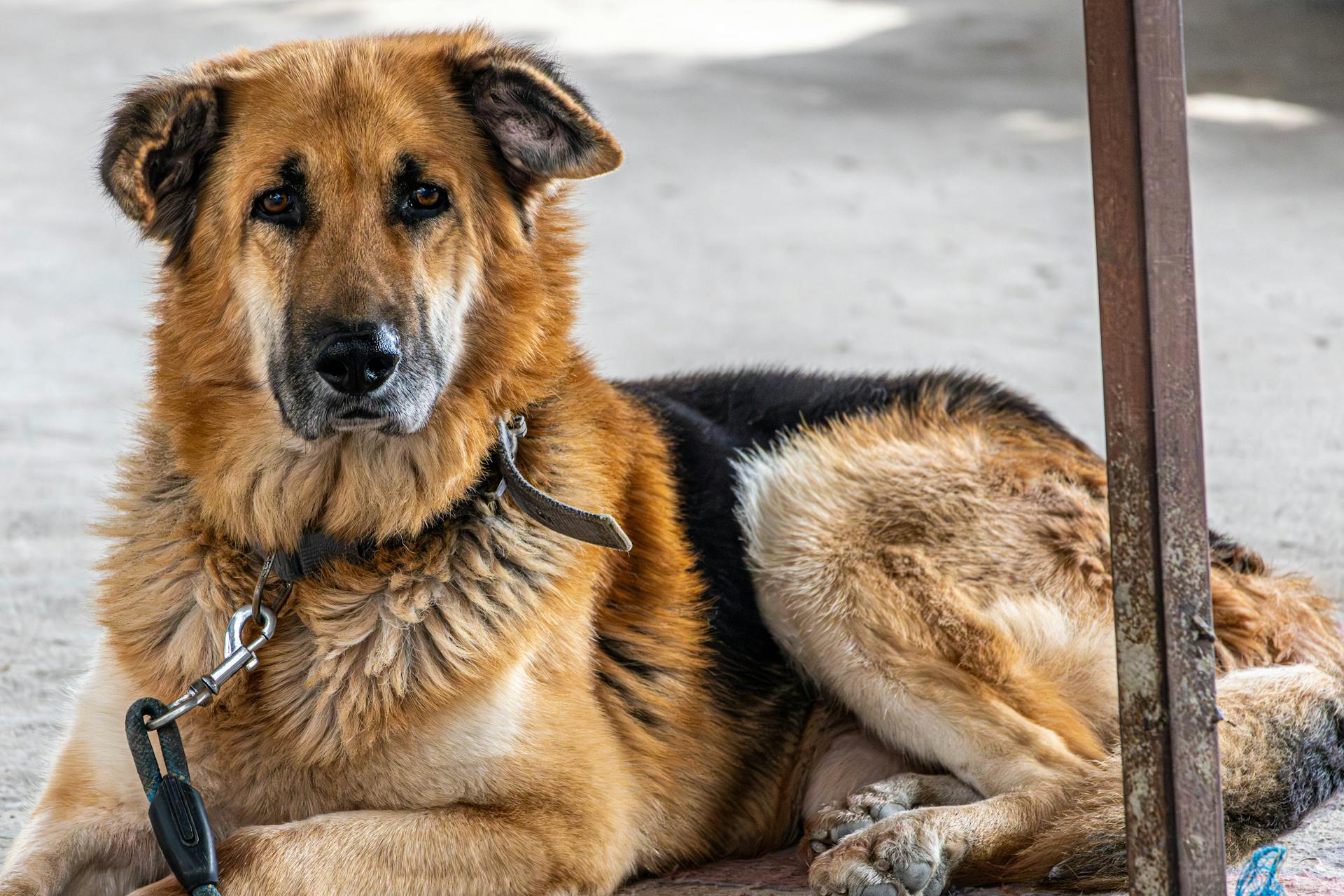
The German Herding Dog, also known as the German Shepherd, is a medium to large-sized breed that originated in Germany in the late 1800s.
This breed was developed to herd sheep and other livestock, and its intelligence, loyalty, and protective nature made it an ideal working dog.
German Herding Dogs are highly intelligent and trainable, with a strong work ethic and a desire to please their handlers.
They are also highly energetic and require regular exercise to stay happy and healthy.
History and Origins
The German Herding Dog has a rich history that dates back to the 1850s in Europe, where shepherds began selecting and breeding dogs for their herding abilities.
In Germany, local communities bred dogs that they believed had the skills necessary for herding sheep, such as intelligence, speed, strength, and keen senses of smell.
The Phylax Society was formed in 1891 to create standardized dog breeds in Germany, but it disbanded after three years due to internal conflicts.
Max von Stephanitz, a former cavalry captain, believed strongly that dogs should be bred for working purposes, and he was instrumental in establishing the modern German Shepherd breed.
Von Stephanitz purchased a dog named Hektor Linksrhein, which he later renamed Horand von Grafrath, and declared him to be the first German Shepherd Dog.
Horand became the center-point of the breeding program and was bred with other dogs that displayed desirable traits, producing many offspring including Hektor von Schwaben and Beowulf.
Beowulf's progeny were also inbred, and it is from these pups that all German Shepherds draw a genetic link, crediting Von Stephanitz with being the creator of the breed.
The Society for the German Shepherd Dog, founded by Von Stephanitz, established a breed standard and registered Horand as the first German Shepherd Dog in 1899.
Physical Characteristics
Today's old German herding dogs look very similar to the ones from the 19th and early 20th centuries. They have been preserved in their traditional form, with breed standards focusing on their herding ability rather than physical appearance.
Their breed standards, when they exist, require that these dogs be capable of herding sheep and cattle. However, physical appearance is rarely prescribed.
These dogs can be divided into sub-groups based on the livestock they herd, such as cow dogs and sheep dogs. The German Society for the Conservation of Old and Endangered Livestock Breeds lists these varieties as "extremely vulnerable" to extinction.
Most of these landraces have no name in English, but approximate translations are shown. Some examples include:
- Kuhhunde, 'cow-dogs'
- Schafhunde, 'sheep-dogs'
The Pomeranian sheep-dog and the herding spitz were also counted among Old German herding dogs, but they became extinct in the second half of the 20th century.
Temperament and Health
German Shepherds are known for their playful and energetic nature, making them a great companion for many families. They are also devoted and protective family members, often trained for watchdog or protection duties.
One of the most significant health concerns for German Shepherds is hip and elbow dysplasia, which can lead to arthritis and pain in later life. This is a result of inbreeding practiced early in the breed's life.
German Shepherds are also prone to ear infections due to their large and open ears. Regular ear cleaning and check-ups can help prevent these issues.
Consider reading: Are German Shepherds Prone to Ear Infections
Temperament
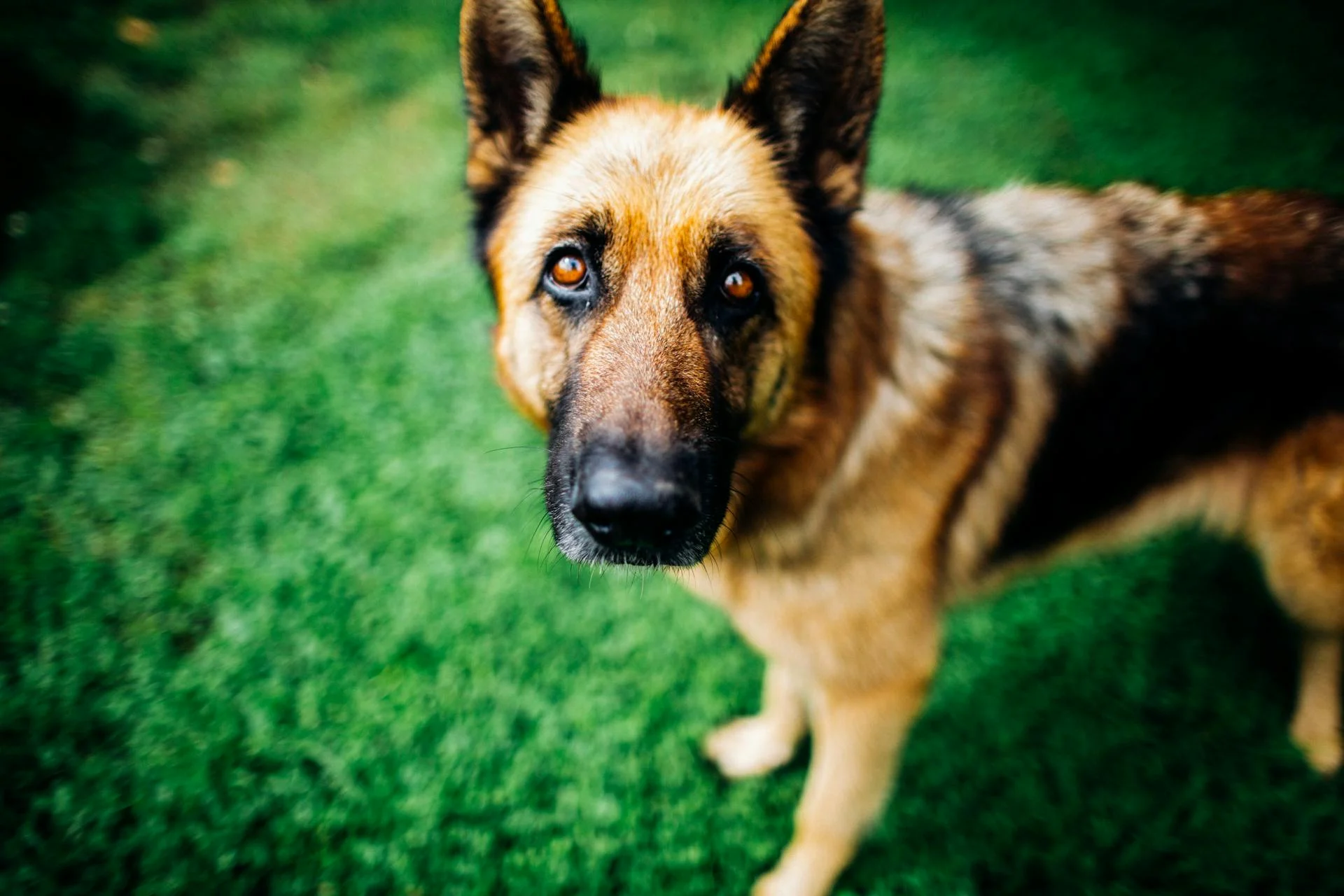
German Shepherds are highly intelligent and obedient, making them a joy to train and work with. They thrive on structure and clear guidance, and with the right training, they can become loyal and devoted companions.
They are naturally protective of their family and territory, which makes them excellent watchdogs and suitable for search missions. However, this protective nature can sometimes get out of hand if not socialized correctly, leading to over-protectiveness.
Their high energy levels and playful nature make them a great match for families with children or the elderly. They love to have a purpose and enjoy training, which is why they're often used as service dogs, search and rescue dogs, and even actors in film and television.
Despite their intelligence, German Shepherds can be overly aggressive if not trained properly, and may become dominant in their relationship with their owner. A firm hand and clear guidance are essential to channel their protective tendencies into positive behaviors.
They will bark in response to perceived threats, but they're not overly noisy or excitable, making them a great choice for families who value a calm and peaceful home.
For another approach, see: Are Great Pyrenees Herding Dogs
Health
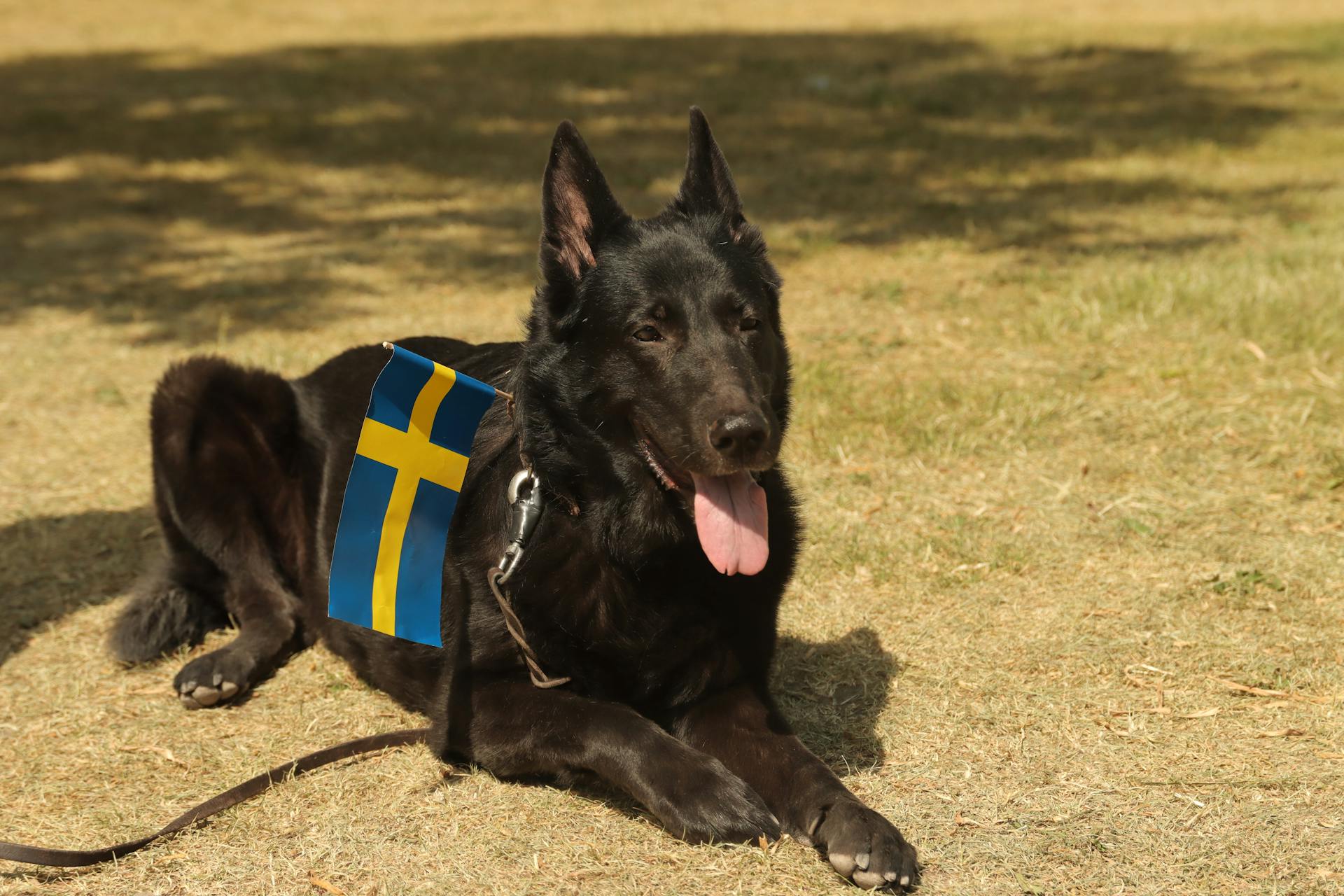
German Shepherds are prone to hip and elbow dysplasia, which can lead to pain and arthritis in later life.
Hip dysplasia affects about 19.1% of German Shepherds, according to the Orthopedic Foundation for Animals.
Ear infections are common in German Shepherds due to their large and open ears.
Degenerative myelopathy, a neurological disease, occurs with enough regularity in the breed to suggest that German Shepherds are predisposed to it.
The median life span of German Shepherds is 10.95 years, which is normal for a dog of their size.
Degenerative spinal stenosis affects about 45% of police working dogs, although the sample studied was small.
A DNA saliva test is available to screen for Degenerative Myelopathy, a mutated gene that can be bred out of the breed.
Care and Use
The German Shepherd Dog is a highly versatile breed that excels in various roles, including search and rescue, guide dog work, and herding.
They are well-suited for scent-work roles due to their keen sense of smell and ability to work regardless of distractions. German Shepherd Dogs can be trained for a wide range of tasks, from detecting narcotics to mine detection.
To care for a German Shepherd Dog, it's essential to provide them with regular exercise and mental stimulation. This can be achieved through activities such as herding sheep or participating in utility dog trials, like HGH herding utility dog trials.
Use as Working Dog
German Shepherd Dogs are highly versatile and excel in various scent-work roles, including search and rescue, cadaver searching, narcotics detection, explosives detection, and mine detection dog.
Their keen sense of smell and ability to work regardless of distractions make them well-suited for these tasks. Their strong sense of duty and fearlessness also make them a great asset in these roles.
In the past, German Shepherd Dogs were the breed of choice for guide dogs for the visually impaired, but in recent years, Labradors and Golden Retrievers have become more widely used. However, German Shepherds are still being trained for this work.
German Shepherd Dogs are also used for herding and tending sheep, where they patrol the boundaries to keep sheep from trespassing and damaging crops.
Additional reading: Breeds of Sheep Herding Dogs
Care and Upkeep
German Shepherd dogs require frequent exercise, especially activities that challenge both their body and mind, such as agility and tracking.
They especially love exercise that gets their heart rate up and engages their problem-solving skills. I've seen them thrive in obstacle courses and scent work.
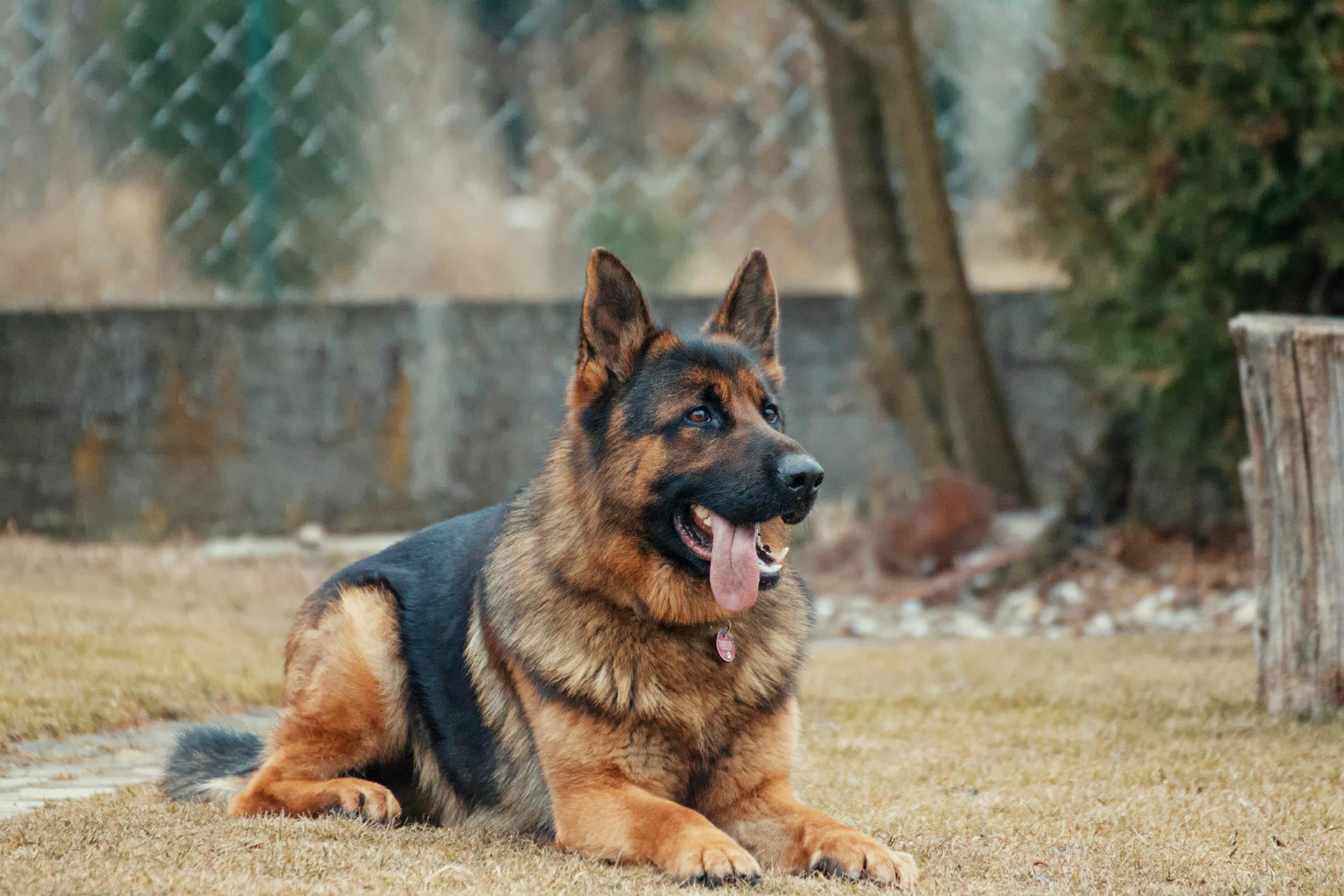
Their high energy levels mean they can be strong swimmers, but it's essential to ensure they have access to a safe and secure area to swim.
Fences should be at least 4 feet high, preferably higher, as they can be skilled jumpers.
Regular bathing is crucial to prevent skin problems that can cause itching, fur loss, and unpleasant odors.
Daily brushing during shedding season can help manage their double coat, but weekly brushing is sufficient for the rest of the year.
German Shepherd dogs are generally hardy in cold and moderately warm weather, but they still need proper care and attention to stay healthy.
Feeding them a large-breed puppy food during development can help reduce the risk of hip dysplasia and other joint disorders.
However, they are susceptible to gastric dilatation-volvulus, a life-threatening condition that requires immediate veterinary attention.
Name and Classification
The German Herding Dog's name has a fascinating history. The breed was originally called Deutscher Schäferhund, which translates to "German Shepherd Dog", reflecting its purpose of assisting shepherds in herding and protecting sheep.
In Germany, all herding dogs were referred to by this name, earning them the nickname Altdeutsche Schäferhunde or "Old German Shepherd Dogs". The breed's name was later changed internationally due to anti-German sentiment after World War I.
Readers also liked: Pit Bulls Real Name
Breed Data

The German Shepherd breed has a rich history and some fascinating facts. The other name for this breed is Alsatian.
One of the most interesting things about German Shepherds is their origin. They originated in Germany, which is not surprising given their name.
Here are some key statistics for the German Shepherd breed:
Their life expectancy is relatively short compared to some other breeds. German Shepherds typically live for 7-10 years.
Name
The name of the breed, German Shepherd Dog, was chosen by von Stephanitz, literally translating to “German Shepherd Dog”. This name was given due to the breed's original purpose of assisting shepherds in herding and protecting sheep.
In Germany at the time, all herding dogs were referred to by this name, hence becoming known as Altdeutsche Schäferhunde or Old German Shepherd Dogs.
Shepherd Dog
The German Shepherd Dog is a highly versatile breed that's used in various roles. They're one of the most widely used breeds in scent-work roles, including search and rescue, narcotics detection, and explosives detection.
Their keen sense of smell and ability to work regardless of distractions make them well-suited for these tasks. German Shepherd Dogs excel in scent work due to their strong sense of duty and mental abilities.
They're also used for herding and tending sheep, patrolling boundaries to keep them from trespassing and damaging crops. This skill is tested in utility dog trials, also known as HGH (Herdengebrauchshund) herding utility dog trials.
Controversy and Description
The German Shepherd breed has been at the center of a controversy surrounding its soundness. The Kennel Club has been involved in a dispute with German Shepherd breed clubs about the issue of soundness in the show-strain breed.
The show-strains have been bred with an extremely sloping topline (back) that causes poor gait in the hind legs. This is a stark contrast to the traditional straight back of the breed found in working-pedigree lines.
Critics of the breed describe it as “half dog, half frog” due to its conformation and movement. An orthopedic vet has even remarked that dogs in a show ring are “not normal”.
Recommended read: Show Me German Shepherd Dogs
Controversy
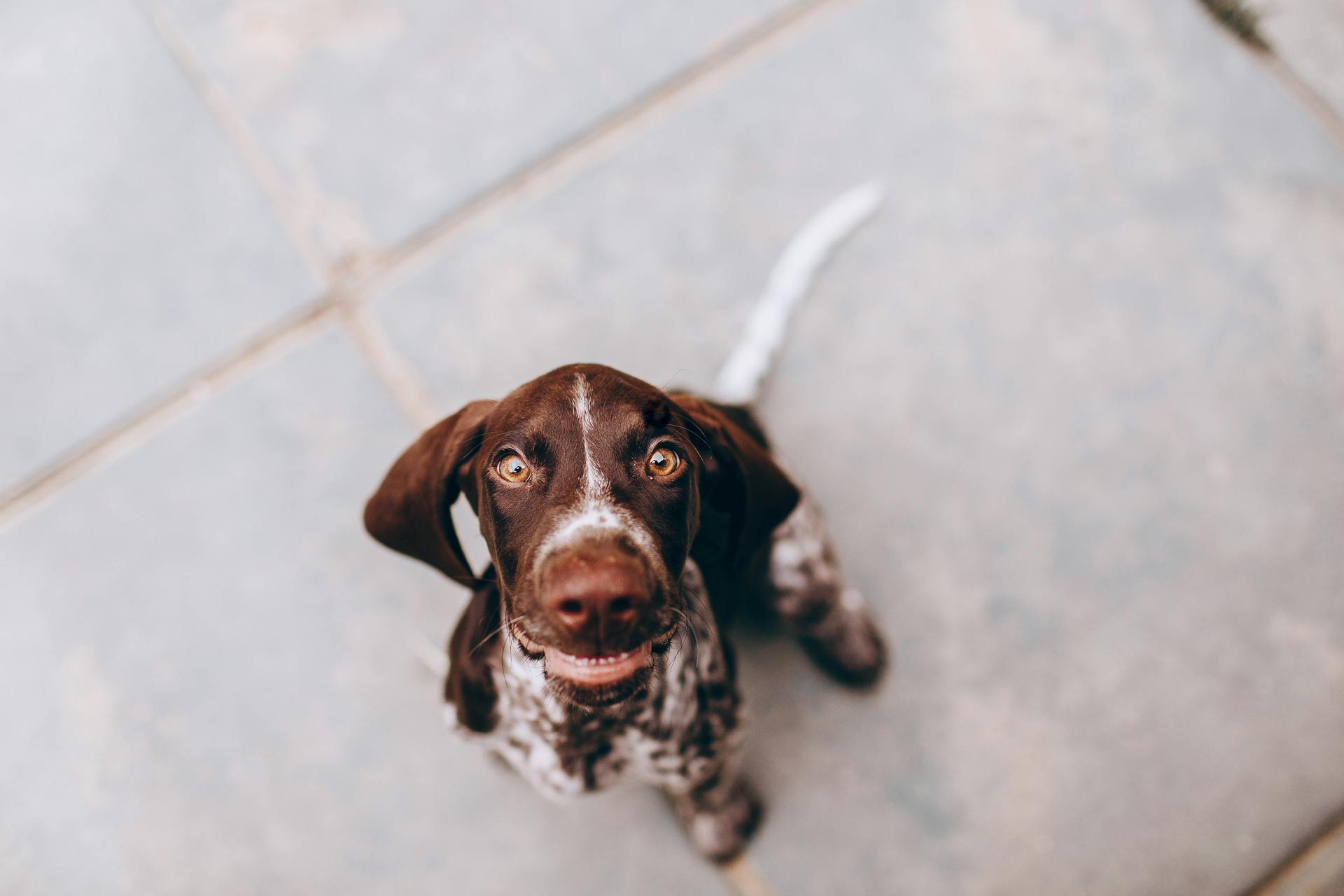
The Kennel Club has been embroiled in a dispute with German Shepherd breed clubs about the issue of soundness in the show-strain breed.
The show-strains have been bred with an extremely sloping topline (back) that causes poor gait in the hind legs. This is a stark contrast to working-pedigree lines, which generally retain the traditional straight back of the breed.
Critics of the breed describe it as “half dog, half frog”, highlighting the severity of the issue. An orthopedic vet has even remarked on footage of dogs in a show ring that they were “not normal”.
The Kennel Club’s position is that “this issue of soundness is not a simple difference of opinion, it is the fundamental issue of the breed’s essential conformation and movement.” They're taking steps to address this, including retraining judges to penalize dogs suffering from these problems.
The Kennel Club is also insisting on more testing for hemophilia and hip dysplasia, other common problems with the breed.
On a similar theme: Herding Dog Behavior Problems
Description
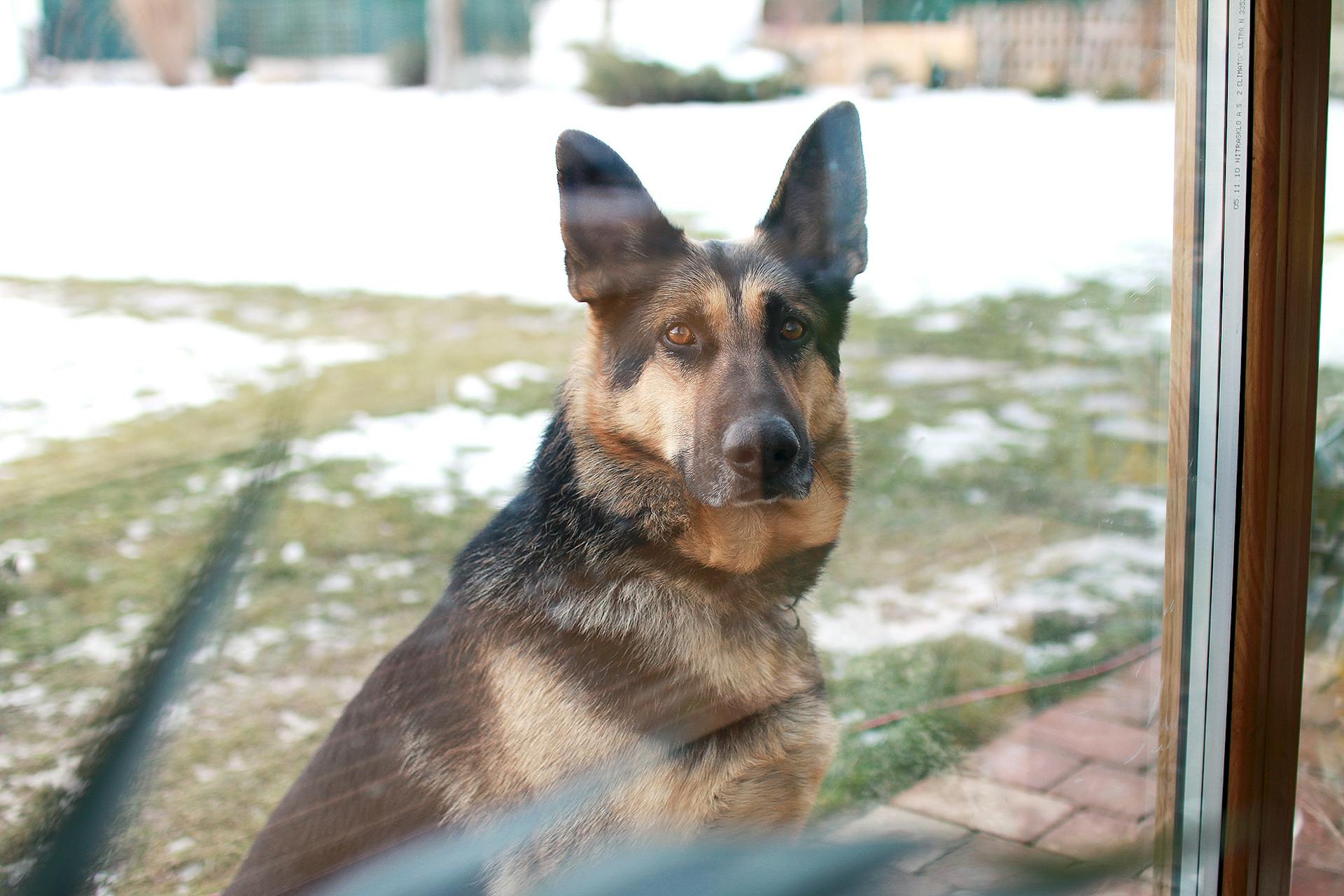
German Shepherds are large sized dogs, generally between 55 and 65 centimetres (22 and 26 in) at the withers, with an ideal height of 63 centimetres (25 in) according to Kennel Club standards.
Their weight is 30–40 kilograms (66–88 lb) for males and 22–32 kilograms (49–71 lb) for females.
They have a domed forehead and a long square-cut muzzle with a black nose.
The jaws are strong, with a scissor-like bite.
Their eyes are medium-sized and brown with a lively, intelligent, and self-assured look.
The ears are large and stand erect, open at the front and parallel, but they often are pulled back during movement.
German Shepherds have a long neck, which is raised when excited and lowered when moving at a fast pace.
Their tail is bushy and reaches to the hock.
The most common colours of German Shepherds are tan/black and red/black, and most colour varieties have black masks and black body markings.
Broaden your view: What to Feed Dogs When Out of Dog Food
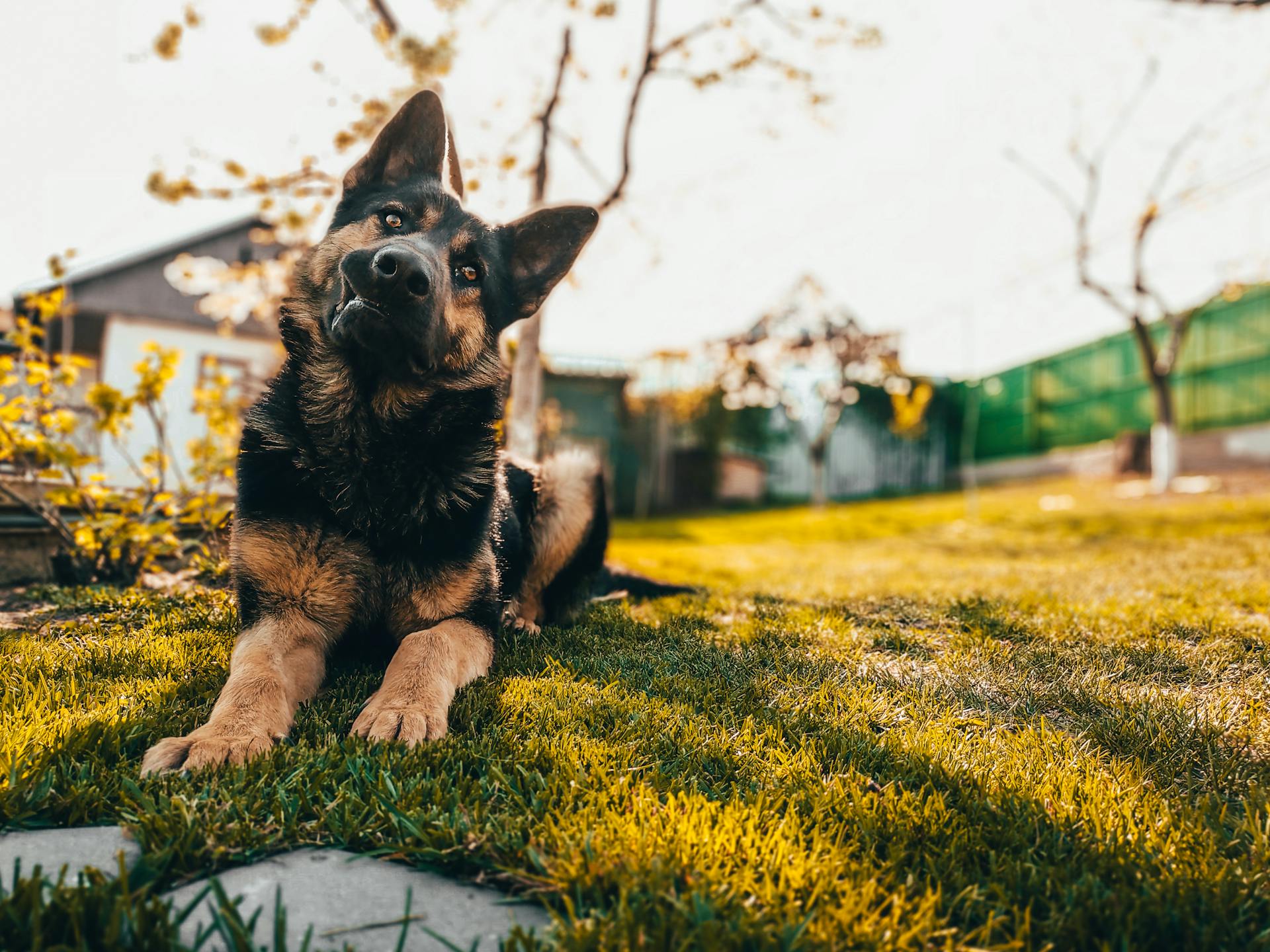
The rarer colour variations include the sable, all-black, all-white, liver, and blue varieties.
German Shepherds sport a double coat, with the outer coat being close and dense with a thick undercoat.
This double coat sheds all year round.
The long-hair gene is recessive, making the long-hair variety rarer.
German Shepherds can have either a medium or long coat, depending on the individual dog.
You might enjoy: White Long Haired German Shepherd Dogs
Frequently Asked Questions
What is the famous dog of Germany?
The German Shepherd is a highly intelligent and popular dog breed from Germany, known for its exceptional abilities and loyalty. Known for its "super-powered snouts", this breed is a favorite among police and military forces worldwide.
Featured Images: pexels.com


